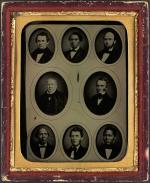![header=[Marker Text] body=[Born at Riverview, near here, Garrett was a prominent abolitionist and Underground Railroad activist. He moved to Wilmington, DE in 1822, and sent many fugitive slaves to his brothers at Riverview, Fernland Farms, and here at Thornfield. He was a devout Quaker and associate of Harriet Tubman and William Still. Although convicted and fined, he aided 2,700 freedom seekers; his commitment to their emancipation was unwavering.] sign](kora/files/1/10/1-A-10B-139-ExplorePAHistory-a0a4h8-a_450.gif)
Mouse over for marker text
Name:
Thomas Garrett
Region:
Philadelphia and its Countryside/Lehigh Valley
County:
Delaware
Marker Location:
Garrett Road & Maple Avenue, Drexel Hill
Dedication Date:
October 25, 1981
Behind the Marker
Thomas Garrett was an active and passionate abolitionist for most of his life. Born in Upper Darby in 1789, he moved to Wilmington, Delaware in 1822. There he became a prominent participant in the antislavery movement, establishing a station on the Underground Railroad. Through his efforts, an active network of people to hide and assist slaves was established throughout the states of Maryland and Delaware.
Garrett attributed his life work to a religious experience he had while living at Thornfield. This experience convinced him to dedicate his life to opposing slavery. He was in his mid-twenties when he returned home one day to discover that a free black woman who worked as a servant for his parents had been kidnapped by slave catchers. While rushing after her, Garrett saw a light above his head and heard a voice that commanded him to "help and defend this persecuted race."
At his death in 1871, obituaries estimated that he had helped more than 2,700 slaves escape, but Garrett himself pegged the number a little lower. In 1863, he sent a report to the American Anti-Slavery Society claiming that from 1825 until 1860, he had "registered" 2,246 fugitives with the Underground Railroad, plus another 73 during the Civil War, bringing his total to just over 2,300.
The famed abolitionist Harriet Tubman was more than just a friend of Garrett's. The two worked together to help hundreds of slaves leave Maryland. Garrett wrote several letters to Underground Railroad organizers in Philadelphia that refer to ongoing operations conducted by Tubman, who was known as the "Moses of her people." These documents offer fascinating insights into the practical side of the escape process.
"Harriet, and one of the men had worn their shoes off their feet," Garrett wrote to Philadelphia abolitionist J. Miller McKim in 1854, "and I gave them two dollars to help fit them out, and directed a carriage to be hired at my expense, to take them out, but do not yet know the expense."
know the expense."
Garrett attributed his life work to a religious experience he had while living at Thornfield. This experience convinced him to dedicate his life to opposing slavery. He was in his mid-twenties when he returned home one day to discover that a free black woman who worked as a servant for his parents had been kidnapped by slave catchers. While rushing after her, Garrett saw a light above his head and heard a voice that commanded him to "help and defend this persecuted race."
At his death in 1871, obituaries estimated that he had helped more than 2,700 slaves escape, but Garrett himself pegged the number a little lower. In 1863, he sent a report to the American Anti-Slavery Society claiming that from 1825 until 1860, he had "registered" 2,246 fugitives with the Underground Railroad, plus another 73 during the Civil War, bringing his total to just over 2,300.
The famed abolitionist Harriet Tubman was more than just a friend of Garrett's. The two worked together to help hundreds of slaves leave Maryland. Garrett wrote several letters to Underground Railroad organizers in Philadelphia that refer to ongoing operations conducted by Tubman, who was known as the "Moses of her people." These documents offer fascinating insights into the practical side of the escape process.
"Harriet, and one of the men had worn their shoes off their feet," Garrett wrote to Philadelphia abolitionist J. Miller McKim in 1854, "and I gave them two dollars to help fit them out, and directed a carriage to be hired at my expense, to take them out, but do not yet
Beyond the Marker







